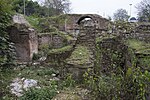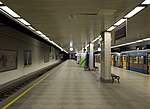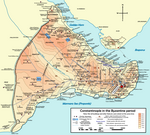Column of Marcian

The Column of Marcian (Turkish: Kıztaşı) is a Roman honorific column erected in Constantinople by the praefectus urbi Tatianus (450-c.452) and dedicated to the Emperor Marcian (450-57). It is located in the present-day Fatih district of Istanbul. The column is not documented in any late Roman or Byzantine source and its history has to be inferred from its location, style and dedicatory inscription. The column is carved from red-grey Egyptian granite, in two sections. The quadrilateral basis is encased by four slabs of white marble. Three faces are decorated with IX monograms within medallions, and the fourth with two genii supporting a globe. The column is topped by a Corinthian capital, decorated with aquilae. The inscription confirms that the capital was originally surmounted by a statue of Marcian, in continuation of an imperial architectural tradition initiated by the Column of Trajan and the Column of Marcus Aurelius in Rome. The basis of the column is orientated northwest/southeast, while its capital is aligned north/south, possibly so that the statue could look towards the nearby Church of the Holy Apostles. A Latin dedicatory inscription is engraved on the northern side of the basis. Its lettering was originally filled with bronze, which has since been removed. The inscription reads: [PR]INCIPIS HANC STATUAM MARCIANI | CERNE TORUMQUE | [PRAE]FECTUS VOVIT QUOD TATIANUS | OPUS (Behold this statue of the princeps Marcian and its base,a work dedicated by the prefect Tatianus.) The Turkish name Kıztaşı, "the column of the girl" (kız: "girl" + taş: "stone"), apparently derives from the genii on the basis, which during the Ottoman period were the column's most distinguishing features (after the loss of Marcian's statue).
Excerpt from the Wikipedia article Column of Marcian (License: CC BY-SA 3.0, Authors, Images).Column of Marcian
Kızanlık Caddesi, Istanbul
Geographical coordinates (GPS) Address Phone number Nearby Places Show on map
Geographical coordinates (GPS)
| Latitude | Longitude |
|---|---|
| N 41.0155 ° | E 28.9502 ° |
Address
Cafe Dolen Pasta
Kızanlık Caddesi
34080 Istanbul
Türkiye
Open on Google Maps









